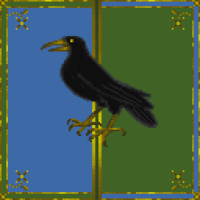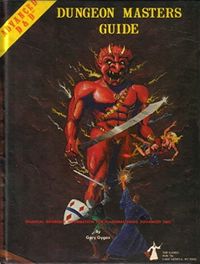Daggerfall:Pen & Paper Worldbuilding

A myth has long circulated that The Elder Scrolls setting was derived from a homebrew Dungeons & Dragons campaign from the very beginning,[1][2] however this isn't exactly factual. The Elder Scrolls: Arena was an original product, heavily derived from Dungeons & Dragons mechanically and as a setting, for sure, but was not a video game adaption of any homebrew campaign.[3] This confusion came about due to the campaign that *was* played during the early development of Daggerfall, which served as a worldbuilding playground to explore potential setting ideas for The Elder Scrolls II before anything had been committed to code.[4][3]
According to Ted Peterson, these weekly pen and paper sessions were dungeon mastered by Julian Lefay and played from during the crunch time of Arena up through the crunch time of Daggerfall, using Advanced Dungeons & Dragons: 1st Edition.[5] The main story was centered around an adversary called the Camoran Usurper, the scion of a Breton woman and the daedra Molag Bal, who had risen to power in the south and was on a westward trek with this supernatural army conquering Tamriel.[5][6] Ted Peterson played Othrok.[7] Vijay Lakshman played Vanus Galerion.[5] Most of the campaign was centered around Dwynnen, with the party traveling around to various kingdoms and interacting with the noble families there to create a coalition against the Usurper.[7] One of these families were the Direnni, coined by Julian.[7][8] Along the way, the map was filled in with various locations that would later appear in the video game.[5] The campaign itself was never finished, so the final confrontation between the party and the Usurper never occurred.[7] Ted Peterson decided to write an ingame history book summarizing the campaign's events for Daggerfall, called The Fall of the Usurper.[5] Due to the fact that the campaign went unconcluded, for the end of the book, he just jotted in a quick sentence explaining that the good guys won in the end.[5] Other elements of the Usurper campaign were also canonized: Vijay's character, Vanus Galerion was written into the lore as the founder of the Mages Guild.[5] Peterson also picked up the Direnni family for the creation of the Medora Direnni character.[5][7][8]
Ted has made a claim that the War of Betony was a campaign they ran as well, as a pen and paper prototyping of the game's backstory.[4] However, his comments on the pen and paper campaigns some time later don't mention this, only citing the Camoran Usurper campaign alone as the story they played out on tabletop.[7][8]
The team ended up dropping the Camoran Ursurper campaign to go play Vampire: The Masquerade instead, this time gamemastered by Ted, which subsequently inspired the inclusion of vampirism as a playable game mechanic.[7]
Ted Peterson recalls the origin for the book Oghma Infinium as having been based off a D&D campaign, where he created a quest to find a great tome called the Orcus Infinium authored by the demon Orcus. As "Orcus" was trademarked, the name was changed to "Oghma", a Celtic deity of wisdom.[8]
Elements of classic The Elder Scrolls games, such as "Giant Goblins from outer realms" or "Ebonarm", are sometimes pointed to as being "homebrew in nature", and get misattributed to the campaign Daggerfall was built out of.[2] However, most of the time, the elements being pointed to were actually the brainchildren of the Council of Wisdom, Daggerfall's fan cabal of beta testers. Bethesda didn't have the resources to pay them for their services at the time, so in return for their help, the developers immortalized the testers' names and characters in the canon of the setting, and encouraged them to write their own stories about the setting, which the developers edited together and then included in the final game as readable novels.[5][8]
References[edit]
- ^ The Elder Scrolls - 10th Anniversary
- ^ a b Michael Kirkbride's Posts
- ^ a b Interview with the Father of the Elder Scrolls by Indigo Gaming
- ^ a b A History of The Elder Scrolls
- ^ a b c d e f g h i Interview with Ted Peterson by Indigo Gaming
- ^ The Daggerfall Chronicles — Ronald Wartow
- ^ a b c d e f g Interview with Ted Peterson by Benefactor
- ^ a b c d e Ted Peterson's Posts

